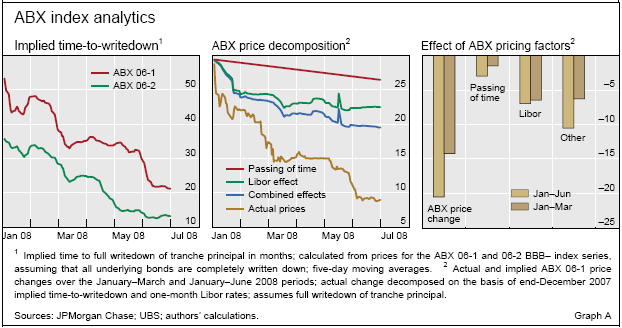ABX pricing mechanics
(Extract from pages 71-72 of BIS Quarterly Review, September 2008)
Prices for ABX index instruments are determined by two payment legs. 1The first leg, which is paid by the protection buyer, is based on the index coupon,2 which, in turn, is fixed as a percentage of notional over the life of the index on the day of the index roll (ie on initiation of a new on-the-run index vintage). As payments are made on a pay-as-you-go basis, the fixed valuation leg can be approximated by the present value of the monthly stream of fixed, default-free coupon payments, adjusted for any prepayments on the underlying bonds. 3The second, floating leg is paid by the protection seller, who makes conditional payments equivalent to any principal writedowns or interest rate shortfalls as determined by Markit, the administration and calculation agent for the ABX indices.
In simplified terms, ABX prices can therefore be written as:
price = 100 + PV (coupons) - PV (writedowns, shortfalls)
where the PV expressions denote the present values of the fixed (coupons) and floating (writedowns, shortfalls) payment legs, respectively.
On this basis, market participants' expectations regarding future writedowns of tranche principal are key factors in determining ABX prices. These, in turn, depend on information such as prepayments and delinquencies, while writedown timing assumptions and discount rates are important parameters in calculating present values. Specifically, if writedowns are assumed to occur immediately (zero months to default) and with coupon payments given, prices will be determined by the number of bonds written down. Broadly put, 10 immediate writedowns (ie half of the underlying MBS tranches) will result in a price of 50, whereas 15 writedowns (75% of all tranches) imply a price of 25. 4Alternatively, if all tranches are assumed to be written down, expectations about writedown timing, combined with any risk premia, will translate directly into ABX prices.
Recent ABX pricing can be used to illustrate the interaction of different pricing factors. While house prices had been weakening and delinquencies on the rise for some time, 2007 particularly saw very severe deterioration in the subprime mortgage segment. As mortgage delinquencies ramped up, so did loss projections on subprime mortgage bonds, implying loss rates far exceeding historical precedents? 5As a result, the most junior indices of the more recent ABX series (which are backed by lower-quality exposures than the original 06-1 index vintage) quickly started to trade on an interest-only basis, ie at levels essentially pricing complete principal writedowns of all 20 underlying MBS tranches. The 06-1 BBB- index, in turn, began to follow the same pattern during the first quarter of 2008, suggesting that writedown expectations were approaching 100%.
With total loss of principal seen as increasingly certain, observed prices (abstracting from any risk premia) thus turned into a broad reflection of traders' expectations as to when tranche writedowns would take place. 6After an initial adjustment during the first quarter of 2008, these implied times-to-writedown declined markedly up to June 2008 for the 06-1 and 06-2 BBB- indices (Graph A, left-hand panel). Part of the underlying decrease in prices was attributable solely to the passage of time and its effect on the discounted value of the (large) floating leg of the respective ABX contracts. The impact of declining Libor rates, however, turns out to have been a more important price determinant, particularly during the first quarter. Under the assumption of total principal writedowns (ie a writedown rate of 100%, discounted over the assumed time-to-writedown), lower Libor rates contributed about half of the price decline for the most junior ABX 06-1 exposures between early January and end-March 2008. Other factors, which would include any risk premia, accounted for the rest of the price movement (Graph A, centre and right-hand panels).
1 A second fixed leg may be paid to reimburse the protection seller for reversed writedowns and interest rate shortfalls.
2 The 2006-1 AAA index is quoted with a coupon of 18 basis points, whereas the corresponding BBB- index has a coupon of 267 basis points.
3 See, for example, Lehman Brothers (2006).
4 See UBS (2007); calculation of writedowns requires deal-level knowledge about the effective attachment and detachment points of the various tranches of ABX constituent deals, which will depend on the amount of overcollateralisation and accumulated excess spread.
5 See Box 1 in Fender and Hördahl (2007) for an illustration.
6 See UBS (2008) for methodological details; cash flows are discounted using one-month Libor; the calculation abstracts from any interest rate shortfalls and payment reversals as these will be dominated by the assumed principal writedown event.

